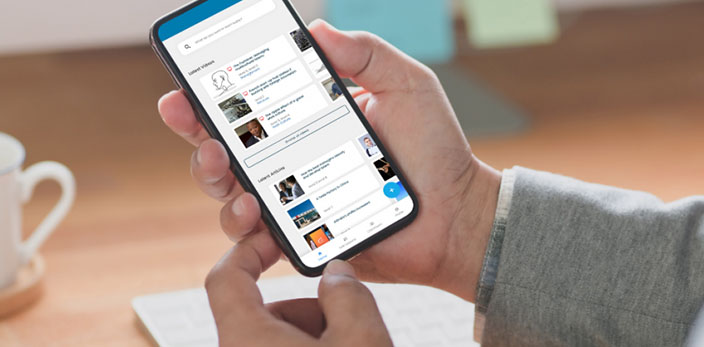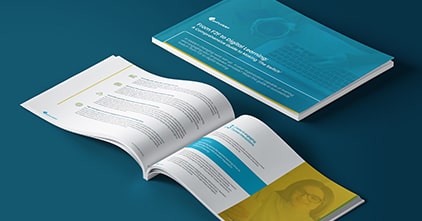The majority of learning leaders are now looking into digital learning to train their employees more efficiently. As you adapt to rising needs at work, it’s great to know how online distance learning can help you personalize your workplace training.

While there’s still much debate whether or not F2F learning is already dead, we’re sure that more and more businesses today are seeking ways to effectively deliver training to their employees… online, and yes, through digital learning!
Here’s why: digital learning augments the F2F training experience and makes it better through digital means. It’s because digital learning provides:
- The same immersive and interactive human connection through video call
- Faster and more convenient scheduling that fits busy people
- 40% less time for the same learning material
More than this, digital learning allows for more personalization which can help your learners reach their optimal learning potentials. If you want to learn more how online training promotes personalized training at work, read on!
Personalization through adaptive learning
For starters and to make things clearer, adaptive learning is more than just personalizing learning. It aims to make training programs and content adapt to learners’ needs, goals, preferences, and current skill levels. In digital learning, this is achieved through artificial intelligence (AI) and machine learning by analyzing a learner’s performance, her/his needs, and modifies the presentation of courses according to that learner’s unique requirement.
But it’s more than that. Having a digital learning platform that operates with adaptive learning systems:
- Saves time – Adaptive learning technology allows real-time personalization as content is tailored according to the learner’s skill level, making learning simpler and faster. It also saves the time of your employees as they no longer need to be present on-site or in the classroom just to attend their training sessions.
- Updates when information changes – In any training and development program, it’s critical to have learning content that is updated and reliable. Since adaptive learning systems track the lessons your learners have already taken, AI and algorithms can recognize changes within your pool of learning content and determine whether or not a certain lesson has already been covered by your learners. This helps learners quickly update themselves without having to go through the entire course.

- Promotes better understanding – With on-demand microlearning content, lessons on complex topics are now easily understood in 12 to 15 minute-long videos. Adaptive learning enables tailor-made focused training that helps learners understand concepts better in line with their own learning preferences.
- Enhances learner engagement – As more and more digital natives are becoming a part of the growing workforce in the world. Great thing, they’re more adaptive to the latest technologies! Digital learning portals now offer engaging course recommendations and Netflix-like user experience that can surely boost your learners’ interest in training.
Mobile learning-based training
Believe it or not, accessibility is still one of the biggest issues faced by learners and learning leaders today, both digital and traditional. But it’s also interesting to know that in 2020, the number of mobile users stood at 6.95 billion globally and this 2021, it’s expected to grow to 7.1 billion.
You may ask — what does this number mean? Think of it this way: as more people are having access to smartphones and more digital natives entering the workforce, it’s an opportunity to promote more mobile learning at work. In fact, the eLearning Industry said that mobile learning is now a necessity instead of just a “bonus.”
As we know, it’s made possible through digital learning advancements. Looking at mobile learning at a personalized training point-of-view, training courses administered in mobile phones are now easily accessible to your employees. They can now learn anytime and anywhere, based on their own convenience.
More so, a study on mobile learning personalization reported that personalization in mobile learning is achieved through two adaptive approaches: (1) adapting to the learner and (2) adapting to the learner’s surroundings.
The key takeaway here is that mobile learning systems allow for context-aware knowledge structure to help learners have the most relevant information and courses right in front of them. And of course, it lets your employees select their preferred topics and lessons they can learn on-to-go. These, then, will affect other learning content recommendations they’ll be receiving in the future, making learning more seamless and tailored.
Supplementary learning content
Speaking of learning content, it’s not only the personalized learning technology that’s responsible for whether or not your digital learning program will be successful. It also lies on the learning content your learners have access to.
For instance, goFLUENT ensures that language training content is relevant for business professionals from different industries through specific courses (e.g. automotive industry, aviation industry, business communication training courses). Here, learning content enhances the personalized learning experience of your employees since it’s hyper-focused on the interests and needs of your learners.
As an example, for language training, if you’re working for the medical industry and your employees often communicate with Italian colleagues, it’s best if you provide your learners with a language training course that features medical jargons and terms through Italian lessons, making it easier for them to converse in the target language using the most useful sentences and phrases to them.
In digital learning, it’s more possible than ever to deliver content in the right time through an adaptive learning system that already knows the preferences, progress, and learning styles of your employees, making learning enjoyable and engaging to them.

Differentiated eLearning
In the traditional classroom set-up, more often than not, instructors follow a “one-size-fits-all” solution that they try to modify on the fly whenever the need for more “personalized” learning arises. But this entirely misses the point of personalized learning!
On the other hand, digital learning (through differentiated learning) involves considering the individual needs of all learners even if they all belong to the same virtual classroom. But before things get more mixed up, we should know the difference between differentiated learning and individualized instruction.
So in differentiated learning, while it still considers individual learning needs, this doesn’t mean trainers have to create a customized lesson for each individual learner; this would be unsustainable.
Instead, the key principle is “flexible groups” which allows for more contextualized learning for learners within a group. For example, goFLUENT’s Group Classes allow learners from the same team and company to have language lessons together via video call (e.g. through Microsoft Teams). Here, the trainer can address the unique needs of those particular learners when it comes to different aspects of their language training.
So digital learning here allows for a more familiar learning environment for your employees that operates within the same context they all can relate to. Through other digital learning tools, a learner can also do self-directed learning which then allows for more personalized learning.
Personalized reports and assessments
Aside from all the learning tools online training can offer for personalization, another important aspect of digital learning technology is that it enables personalized reports for learners.
Compared to traditional instructor-led training (ILT), learning systems are able to send customized evaluations to learners and their training managers in real-time. Having this, it’s now more accessible for you and your learners to track their progress and see whether or not there’s an ROI in your current training and development programs.
More than this, learning systems can also administer leveling tests and diagnostics. As an example, in the goFLUENT portal, learners’ language levels can easily be identified through initial diagnostics. The results can be seen immediately after taking the test.
This is very important because this helps both the trainers and the learning system (through adaptive learning technology) to determine the most appropriate courses that each learner needs. At the same time, further content suggestions will also be based upon this and the succeeding personalized assessments.

Takeaway
One of the best things about digital learning for organizations is that it allows for more personalized learning experiences which makes L&D programs more than just a necessity but also something that learners can fully enjoy. The same way that we’re fully immersed in curated playlists, TV shows, and other media, it’s the same with corporate training. Having a digital learning program in place can help boost your training engagement and utilization which then can upskill and reskill your learners faster and more effectively.



